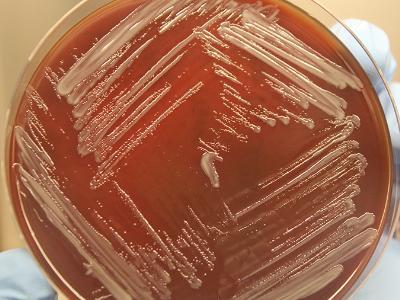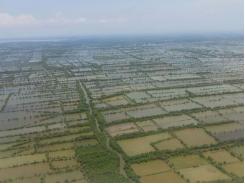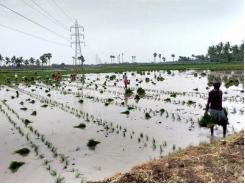Studying the stubborn salmon disease SRS from afar

UMaine researcher digging into Piscirickettsia salmonis to present at June conference
P. salmonis grown on a blood-agar based plate. Photo by Daniel Makrinos.
Since last February, when Daniel Makrinos began studying the salmonid disease Salmonid Rickettsial Septicaemia (SRS or piscirickettsiosis), he’s been “entrenched” in researching the destructive bacterium that causes it. Makrinos, a researcher at the University of Maine, has been poring through published research and growing samples in his lab to greater understand, and hopefully control, the bane of Chile’s farmed salmon industry.
Costing the industry a reported $100 million or more annually in economic losses, the Piscirickettsia salmonis, or P. sal, bacterium is difficult to detect and can spread quickly, causing massive mortalities if not treated quickly, Makrinos told the Advocate.
“It occurs after fish are transferred from freshwater to seawater net pens. If fish are not properly protected, P. sal will certainly be a happy customer,” he said.
First reported in Chile in the late 1980s, P. sal is an intracellular organism, meaning it survives and proliferates inside host cells (macrophages) or when grown in vitro (tissue culture cells). It’s also facultative, which means the pathogen can grow outside a host cell and can survive in more than one type of environment.
SRS is having a major impact on Chile’s salmonid (Atlantic salmon, coho salmon and rainbow trout) producers, many of whom suffered major losses over the past decade due to the more highly publicized Infectious Salmon Anemia (ISA) virus. Producers are trying divalent vaccines to combat both ISA and SRS, Makrinos said, but industry observers say that a proven P. sal-specific vaccine has yet to be found.
The transfer of eggs or even whole fish between countries has not specifically been identified as a source of transmission, however it should be done with caution. The industry doesn’t need this bug to go any further than it already has.
According to seafood industry reports, the Chilean government has put up $20 million for a four-year SRS research project, with one-quarter of the funds coming from the industry. Pete Bridson, founder of Seagreen Research, told the Advocate earlier this month that rickettsia is the leading reason why Chile uses “large amounts of antibiotics,” and that the development of an effective vaccine could change public perceptions of the industry in Chile and radically improve its market prospects.
In 2014, Chile produced 895,000 metric tons (MT) of fish and used 563,200 kilograms (1.2 million pounds) of antibiotics, according to government and industry data. Antibiotic use had risen 25 percent from 2013. Norway produced more than twice as much salmon (1.3 million MT) but used only 972 kilograms of antibiotics in 2013.

Pharmaq announced last month that its attenuated live vaccine Alpha Ject LiVac® SRS received a provisional marketing authorization from the Chilean authority Servicio Agrícola y Ganadero de Chile. Photo courtesy of Pharmaq.
Pharmaq, a leading aquaculture vaccine manufacturer based in Norway, announced last month that its attenuated live vaccine Alpha Ject LiVac® SRS received a provisional marketing authorization from the Chilean authority Servicio Agrícola y Ganadero de Chile and is now available to the industry. Pharmaq President Morten Kr. Nordstad said the “ground-breaking” injectable vaccine, developed through years of research, is highly requested by industry for more predictable and reliable production.
An immunization system developed by another Chile-based pharmaceutical firm, Veterquimica, is an immersion vaccine that the company is positioning as a cheaper alternative to antibiotics. Six producers in Chile tested Rickemune Vax Immersion last summer. Also last summer, Tecnovax in Argentina partnered with Nissui-owned Salmones Antartica with the aim of developing an SRS vaccine within two years.
Makrinos will present his P. sal findings during the 2nd International Conference of Fish and Shellfish Immunology (ICFSI), to be held in Portland, Maine, USA, at the Holiday Inn by the Bay from June 26 to 30, 2016. Makrinos’ presentation, “A Comparative Immune Response to Piscirickettsia Salmonis Grown in Alternative Media,” will be given on June 30 at 11:45 a.m. during the Host-Pathogen Interactions section of the program.
Makrinos confirmed that he is working on an SRS vaccine, but couldn’t elaborate any further. Growing the bacterium in a laboratory setting is exceptionally difficult, he added, even as knowledge of SRS and its treatments has been increasing in recent years.

A cytopathic effect (CPE) of tissue culture cells (CHSE-214). “This is what I look for in tissue culture, which indicates that P. sal is proliferating inside the cell and causing the circular swelling look that you see and plaque-like zones of clearance where cells are killed,” said University of Maine researcher Daniel Makrinos.
“Up until 2007, it was believed to be obligate in growth and unable to grow on any sort of solid or liquid medium,” he said. “For ICFSI, my talk is going to be based around different agar and broth cultures which enable growth of the pathogen outside a host cell making it facultative.”
As far as preventative measures, Makrinos said that site fallowing is a “crucial” practice for producers, as the P. sal bacterium can survive in the water column for up to 50 days. Stocking density is a major factor in the spread of the disease, he added.
“When fish are too packed in, it is so easy for a pathogen like P. sal to go crazy. The transfer of eggs or even whole fish between countries has not specifically been identified as a source of transmission, however it should be done with caution,” he warned. “The industry doesn’t need this bug to go any further than it already has.”
More than 200 international delegates participate in the event, representing universities, research institutions and industry, to reduce disease in farmed fish and shellfish, improve animal welfare, reduce the impact of antibiotics on the environment through the use of vaccination, and ultimately to produce a superior market product for the consumer.
@GAA_Advocate
James Wright
Editorial Manager, Global Aquaculture Alliance, Portsmouth, NH, USA
Related news
Tools

Phối trộn thức ăn chăn nuôi

Pha dung dịch thủy canh

Định mức cho tôm ăn

Phối trộn phân bón NPK

Xác định tỷ lệ tôm sống

Chuyển đổi đơn vị phân bón

Xác định công suất sục khí

Chuyển đổi đơn vị tôm

Tính diện tích nhà kính

Tính thể tích ao



 Omega-3 levels fall in farmed salmon but it’s…
Omega-3 levels fall in farmed salmon but it’s…  Aquaculture viruses: An Atlantic salmon case study
Aquaculture viruses: An Atlantic salmon case study